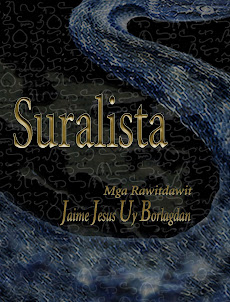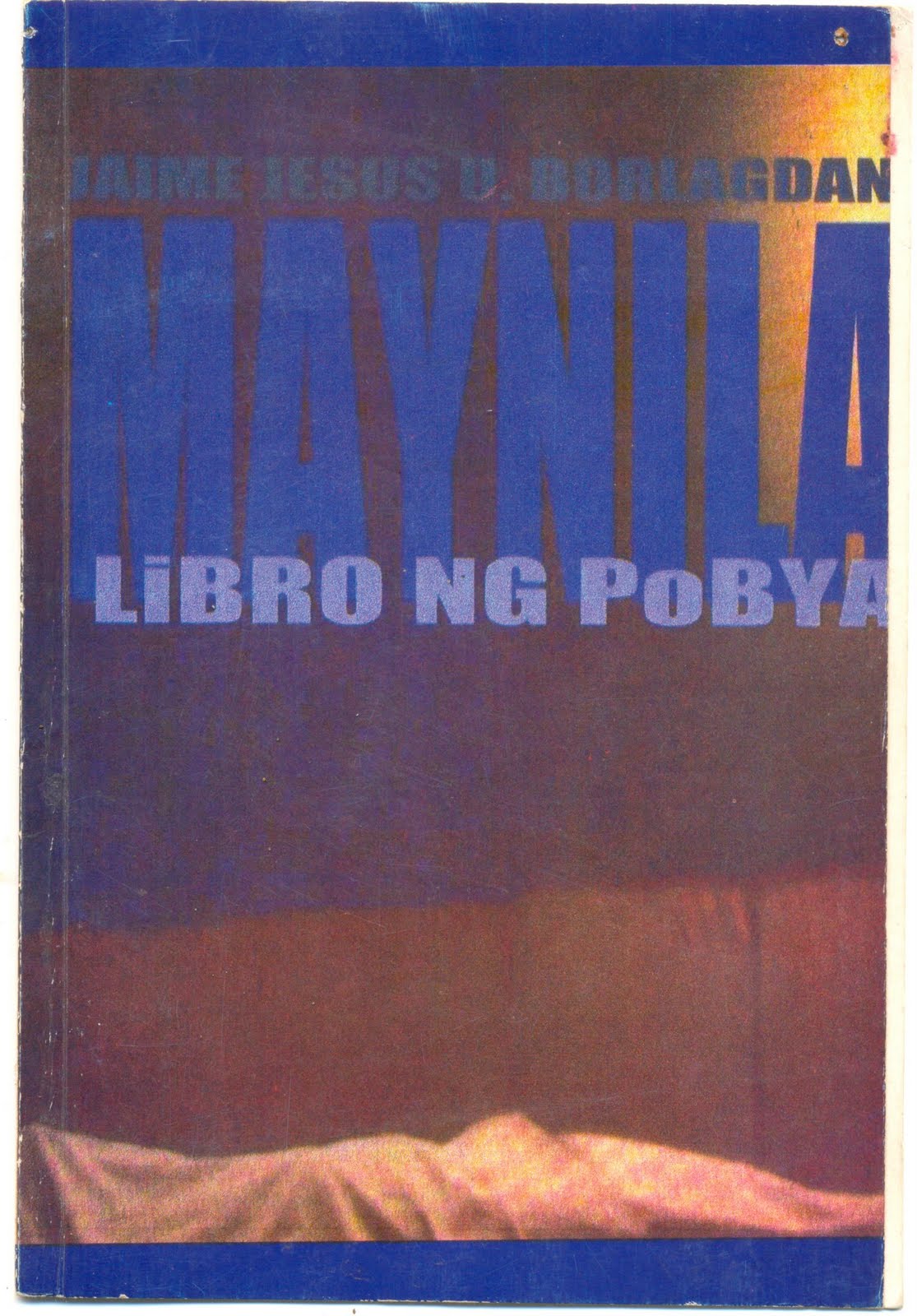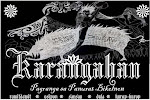
Kan nilaog siya sa harong
arog kan awot na ginabot sa magapo
dangan tinanom sa maray na daga,
kan su sinaray niyang isog nawaran ki kamugtakan,
nagadan na man su pagmawot niyang mabuhay.
Sa imbong kan mga lanob
na daing lipot na pigpapalaog
luminatang su saiyang tulang
na napupungaw sa pangangaipo
ki paglakop.
Su lawas niyang dai na nahihigot
ki punaw buda pakig-agaw,
huminewas sa rasay
kan ubos na mga laogan.
Ta hali digdi kuminamang
an dakol na burak kan buru-banggi
niyang pag-utob
sinurop su saiyang sapog.
Natada saiya an masakrot
na duga kan pag-alang.
Dangan siya buda an bintana
pagturog na an gabos
pigsasapar an haldat kan imon
sa layas na mga bituon.
Saro siyang awot
na ginibong tinanom.
Tabang saiya an panahon
na maako an saiyang pagkatanom.
An saiyang ogma mga ngipon
kun kaipuhan niyang pahilingon.
Naubos na
su saiyang mga ngipon.
Sa balkon kan saiyang pagsulnop,
pighiling niya su laog kan saiyang kamot.
Pigsusog duman su mga dalan kan salog.
Punas na kan haloy na dai pagmawot.
Bago abutan kan diklom
luminuwas siya sa harong.
Naglakaw na daing kiling,
na garo dai nang kikilingan
sagkod maabot
an lugar na daing kasiguruhan.
An kadlagan
kun sain sana siya may kasiguruhan.
Duman an paghangos
na haloy pinugol
giraray pinunan.
Enero 10, 2007. Pawa.
Translation:
A story of a weed
When she was housed
like a weed pulled from rocks
then planted on fertile soil,
when her kept wildness lost its sense,
death came to her will to live.
Under the warmth of walls
which allow no coldness
her bones became lacy
longing for the need to spread.
No longer tightened
by hunger and competition,
her body loosened in a fall
of empty containers.
For from this crawled
many flowers of her nightly
obedience
sucking her sap.
What was left of her is the bitter
juice of dried-ness.
And when everything is asleep,
she and the window
suffers the burn of jealousy
for the wild stars.
She is a weed
made into a plant.
Time aids her
to accept her plant-ness.
Her happiness are teeth
when she needs to show it.
She lost all her teeth.
In the porch of her setting,
she stares at the inside of her palm.
Tracing there river paths.
Erased by the long absence of desire.
Before darkness reaches her
she steps out of the house.
Walks without looking back,
like there's nothing there to look back for
until reaching
a place of uncertainty.
The forest
where she has certainty.
There the breathing
that was long held
is again begun.
Ako Kalag Omay (2015)
Buhay-Gadan (2014)
Ha'dit sa byahe buda iba pang mga bagahe (2013)
X (2012)
Hamot kan Narumdom (2011)
Suralista: Mga Rawitdawit (2010)

Makukua sa: Gabos na Lucky Educ. outlets (Naga, Legazpi, Tabaco, Polangui, Sorsogon); Tabaco: Arden,Imprintados Advertising. Naga: Lucky Educational Supply. O kaya sa 0917 524 2309
Que Lugar Este kan Dayo sa Sadiring Banwa (2009)

"Maunod, magabat. Alagad makamuyahon ta magian basahon, ta makamuyahon saka labas an tanog. Makata, uragon." Gode B. Calleja. Abilable sa gabos na Lucky Educ. Supply Outlets; Kulturang Bikolnon. For inquiries:0917 524 2309
Maynila: Libro ng Pobya (1999)

Makukua sa gabos na Lucky Educ Supply outlets buda sa Imprintados Ads sa Tabaco City. Para sa mga kahaputan mag-text sa 0917 524 2309
Karangahan Online
On Borlagdan's Poetry
A Rush of Metaphors, Tremor of Cadences, and Sad Subversions
By Tito Genova Valiente
titovaliente@yahoo.com
The first time I read the poems of Jesus Jaime Borlagdan, Jimple to those who know him, I felt immediately the seething movement of the words. There was a rush of metaphors in his works. I immediately liked the feeling that the rhythm caused in one’s reading for poetry, in my book, should always be read aloud. I was hearing the voice. It was a voice that happened to sound from afar and it was struggling to link up with a present that would not easily appear.
It was heartbreaking to feel the form. I felt the lines constricting. I saw the phrases dangling to tease, breaking the code of straight talk and inverting them to seduce the mind to think beyond the words. Somewhere, the poems were reverting back to direct sentences, weakening the art of poetry with its universe of ellipses and nuances, but then as suddenly as the words lightened up, the poems then dipped back into a silent retreat, into a cave, to lick its own wounds from the confrontation that it dared to initiate.
For this column, I decide to share parts of the longer paper I am writing about this poet.
In Karangahan, the poet begins with: Bulebard, ikang muymuyon na salog/ki gatas buda patenteng nakahungko,/ako ngonian kahurona. Borlagdan translates this into:Boulevard, you forlorn river/ of milk and downcast lights/ speak to me now. Savor the translation, for in Bikol that which is a dialog has become an entreaty.)
The poet is always talking to someone but in An istorya ninda, an osipon ta, he talks about a the fruits of some narrative: Ta sa dara nindang korona kita an hadi/ sa krus, kita su may nakatadok na espada./Naitaram na ninda an saindang istorya./Punan ta na man su satong osipon./This I translate as: For in the crown they bear we are the King/ on the cross, with the embedded sword./ Marvel at this construction, as the poet cuts at the word “hadi” and begins the next line with “krus” and the “espada.” Marvel, too, at how he looks at conversion and faith, a process that made us special but also wounded us with ourselves stuck with the sword.
Finally, the poet says those lines of the true believer: They have already spoken their story, now let us begin with our tale. The poet does not have a translation but will the istorya in this line be “history” and osipon be “myth.” Shall these last four lines in the first stanza be both a subversion of our faith embedded in a foreign culture or a celebration of what we are not, and what we have not become?
Puni na an paghidaw. Puni na an pagluwas/hali sa kwartong pano ki luha, puni na/an paghiling sa luwas kan bintana./Puni na an paghidaw para sa binayaan./Puni na an pagsulit sa daluging tinimakan./Puni na an paghidaw sa mga sinugbang utoban. Terrifying lines as the poet calls us to begin the remembering and also begin the moving out from the room full of tears. In the poet’s mind, the lacrimarum vale or valley of tears had become an intimate area for instigating his own release.
The rhythm is there as in a prayer. But it is no prayer. There is the repetition but it is not a plea. There is the self but it is one that has turned away from itself into something else. That self is one that shall face the recollection of the faith that has been burned.
And yet the poet, resolute when he wants to, loves to sing and hint of fear and anxiety. Even when he is merely observing children playing in the rains, he summons images of terrible beauty. The skies become diklom na pinandon na “may luho” (with hole). From this hole, comes the sarong pisi ki sildang/ tisuhon na buminulos. The poet stays with this metaphor with such intensity that the silken thread coming from the hole justifiably becomes luhang garo hipidon na busay/paluwas sa mata/kan dagom. Dark wit and a penchant for the horrifying are tandem graces in these lines.
This is the poet who can, without self-consciousness, tell us of the …haya/kan mga ayam na namimibi/nakakapabuskad ki barahibo/nakakaulakit ki lungsi. He whispers of “halas na rimuranon, malamti/sa hapiyap kan mga bituon.”
This is a startling universe, where dogs pray (and bay), and where fears bloom and paleness afflicts and infects, and serpents are caressed by the stars.
Blog Archive
-
►
2016
(11)
- ► 11/27 - 12/04 (1)
- ► 11/20 - 11/27 (5)
- ► 04/10 - 04/17 (1)
- ► 03/20 - 03/27 (1)
- ► 02/21 - 02/28 (2)
- ► 02/07 - 02/14 (1)
-
►
2015
(12)
- ► 11/01 - 11/08 (1)
- ► 10/25 - 11/01 (2)
- ► 09/20 - 09/27 (1)
- ► 03/29 - 04/05 (3)
- ► 03/15 - 03/22 (2)
- ► 02/01 - 02/08 (1)
- ► 01/18 - 01/25 (1)
- ► 01/11 - 01/18 (1)
-
►
2013
(23)
- ► 05/26 - 06/02 (1)
- ► 05/19 - 05/26 (1)
- ► 05/12 - 05/19 (1)
- ► 05/05 - 05/12 (1)
- ► 04/28 - 05/05 (1)
- ► 04/21 - 04/28 (2)
- ► 04/14 - 04/21 (2)
- ► 04/07 - 04/14 (1)
- ► 03/31 - 04/07 (1)
- ► 03/24 - 03/31 (1)
- ► 03/17 - 03/24 (1)
- ► 03/10 - 03/17 (1)
- ► 03/03 - 03/10 (1)
- ► 02/24 - 03/03 (1)
- ► 02/17 - 02/24 (1)
- ► 02/10 - 02/17 (1)
- ► 02/03 - 02/10 (1)
- ► 01/27 - 02/03 (1)
- ► 01/20 - 01/27 (2)
- ► 01/13 - 01/20 (1)
-
►
2012
(59)
- ► 11/04 - 11/11 (2)
- ► 10/28 - 11/04 (4)
- ► 10/21 - 10/28 (2)
- ► 10/14 - 10/21 (3)
- ► 09/30 - 10/07 (1)
- ► 09/23 - 09/30 (1)
- ► 09/16 - 09/23 (1)
- ► 09/09 - 09/16 (2)
- ► 08/26 - 09/02 (1)
- ► 08/12 - 08/19 (1)
- ► 08/05 - 08/12 (1)
- ► 07/29 - 08/05 (1)
- ► 07/15 - 07/22 (1)
- ► 07/08 - 07/15 (1)
- ► 05/20 - 05/27 (2)
- ► 05/06 - 05/13 (2)
- ► 04/29 - 05/06 (4)
- ► 04/22 - 04/29 (1)
- ► 04/08 - 04/15 (1)
- ► 04/01 - 04/08 (5)
- ► 03/25 - 04/01 (2)
- ► 03/18 - 03/25 (1)
- ► 02/19 - 02/26 (1)
- ► 02/05 - 02/12 (1)
- ► 01/29 - 02/05 (4)
- ► 01/22 - 01/29 (4)
- ► 01/15 - 01/22 (7)
- ► 01/08 - 01/15 (1)
- ► 01/01 - 01/08 (1)
-
►
2011
(34)
- ► 12/11 - 12/18 (1)
- ► 12/04 - 12/11 (1)
- ► 11/20 - 11/27 (1)
- ► 11/06 - 11/13 (2)
- ► 10/30 - 11/06 (1)
- ► 10/16 - 10/23 (1)
- ► 10/09 - 10/16 (3)
- ► 10/02 - 10/09 (5)
- ► 09/25 - 10/02 (1)
- ► 09/18 - 09/25 (1)
- ► 08/28 - 09/04 (2)
- ► 07/31 - 08/07 (1)
- ► 07/24 - 07/31 (1)
- ► 07/03 - 07/10 (1)
- ► 06/26 - 07/03 (1)
- ► 06/12 - 06/19 (1)
- ► 05/29 - 06/05 (1)
- ► 05/15 - 05/22 (1)
- ► 04/10 - 04/17 (1)
- ► 03/27 - 04/03 (1)
- ► 03/13 - 03/20 (1)
- ► 03/06 - 03/13 (1)
- ► 02/27 - 03/06 (1)
- ► 02/13 - 02/20 (1)
- ► 01/23 - 01/30 (1)
- ► 01/09 - 01/16 (1)
-
►
2010
(28)
- ► 12/26 - 01/02 (1)
- ► 12/12 - 12/19 (1)
- ► 11/28 - 12/05 (1)
- ► 11/14 - 11/21 (1)
- ► 10/31 - 11/07 (1)
- ► 10/10 - 10/17 (1)
- ► 09/26 - 10/03 (1)
- ► 09/19 - 09/26 (1)
- ► 09/12 - 09/19 (1)
- ► 08/29 - 09/05 (1)
- ► 08/15 - 08/22 (1)
- ► 07/25 - 08/01 (1)
- ► 07/11 - 07/18 (1)
- ► 06/27 - 07/04 (1)
- ► 06/13 - 06/20 (1)
- ► 05/30 - 06/06 (1)
- ► 04/25 - 05/02 (1)
- ► 04/11 - 04/18 (1)
- ► 03/28 - 04/04 (1)
- ► 03/14 - 03/21 (1)
- ► 02/28 - 03/07 (1)
- ► 02/14 - 02/21 (2)
- ► 01/31 - 02/07 (1)
- ► 01/24 - 01/31 (1)
- ► 01/10 - 01/17 (2)
- ► 01/03 - 01/10 (1)
-
▼
2009
(20)
- ► 12/20 - 12/27 (1)
- ► 12/13 - 12/20 (1)
- ► 11/22 - 11/29 (1)
- ► 11/15 - 11/22 (1)
- ► 10/25 - 11/01 (1)
- ► 09/06 - 09/13 (1)
- ► 08/02 - 08/09 (1)
- ► 07/05 - 07/12 (1)
- ► 06/21 - 06/28 (1)
- ► 05/31 - 06/07 (1)
- ► 05/10 - 05/17 (1)
- ► 05/03 - 05/10 (1)
- ► 04/12 - 04/19 (1)
- ► 03/29 - 04/05 (1)
- ► 03/15 - 03/22 (1)
- ► 03/01 - 03/08 (1)
- ► 02/01 - 02/08 (1)
- ► 01/25 - 02/01 (1)
- ► 01/11 - 01/18 (1)
-
►
2008
(14)
- ► 12/28 - 01/04 (1)
- ► 11/30 - 12/07 (2)
- ► 11/09 - 11/16 (1)
- ► 10/26 - 11/02 (2)
- ► 10/05 - 10/12 (2)
- ► 09/14 - 09/21 (1)
- ► 08/17 - 08/24 (1)
- ► 08/10 - 08/17 (1)
- ► 07/06 - 07/13 (1)
- ► 06/08 - 06/15 (1)
- ► 05/18 - 05/25 (1)
-
►
2007
(7)
- ► 09/23 - 09/30 (1)
- ► 08/19 - 08/26 (1)
- ► 04/22 - 04/29 (5)
-
►
2006
(7)
- ► 10/15 - 10/22 (3)
- ► 09/03 - 09/10 (4)
-
►
2005
(4)
- ► 07/17 - 07/24 (1)
- ► 05/22 - 05/29 (1)
- ► 04/03 - 04/10 (1)
- ► 02/27 - 03/06 (1)
-
►
2004
(25)
- ► 12/05 - 12/12 (1)
- ► 10/31 - 11/07 (1)
- ► 10/24 - 10/31 (2)
- ► 09/05 - 09/12 (1)
- ► 08/29 - 09/05 (1)
- ► 07/25 - 08/01 (1)
- ► 02/29 - 03/07 (1)
- ► 02/22 - 02/29 (4)
- ► 02/15 - 02/22 (1)
- ► 02/08 - 02/15 (2)
- ► 01/04 - 01/11 (10)
Huron Suralista
Sunodon si Suralista
Facebook Badge
Facebook Badge
Sakuya pa
- Karangahan: Pagranga sa Panurat Bikolnon (ONLINE)
- Introduction to Jimple
- Jimple's Multiply Site
- Paikot sa Kirot: Kalipunan ng mga Tula sa Tagalog
- Que Lugar Este Kan Dayo Sa Sadiring Banwa: Mga Rawitdawit
- Mahalnas na Upon: Katipunan ki mga Osipon buda iba pang hurop-hurop
- Krear Bathala Propaganda Machine




